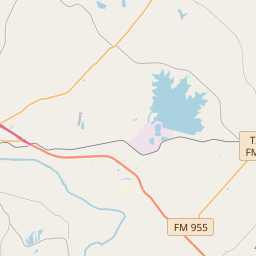St. Mary's Catholic Church
Historical marker location:






In the 1850s, families of German and Czech origin in the Ross Prairie area were served by visiting priests. After 1855, they worshipped in a log church (2 miles N) named Saint Joseph, the first permanent Catholic church in Fayette County. The church moved to Live Oak Hill about 1861, and purchased this site near the settlement in 1864. The first resident priest arrived in 1872, and a larger church structure, named Immaculate Conception of the Blessed Virgin Mary (St. Mary's), was built in 1879. After it burned in 1905, this Gothic-styled church was built here now called Hostyn Hill--in 1906.
Texas Sesquicentennial 1836-1986
The immigration of Czechs to America has a rich history that spans several centuries. Here is a brief timeline highlighting key moments in Czech immigration to America:
1848: The Revolutions of 1848 across Europe, including the Austrian Empire (which included Bohemia and Moravia), sparked political and social unrest. As a result, some Czechs sought political refuge in the United States.
1850s: The first significant wave of Czech immigration to the United States begins. Many Czechs, primarily from Bohemia and Moravia, settle in areas such as Texas, Wisconsin, and Illinois.
1862: The Homestead Act, which offered free land to settlers, attracts Czech immigrants to the American Midwest, particularly to farming communities in Iowa, Nebraska, and Kansas.
Late 19th to early 20th century: The peak period of Czech immigration to America. Economic opportunities and escape from political oppression and economic hardship in the Austro-Hungarian Empire drive large numbers of Czechs to emigrate. Many settle in urban areas like Chicago, New York City, and Cleveland, forming vibrant Czech-American communities.
1918: The creation of Czechoslovakia as an independent nation following World War I leads to a decrease in Czech immigration to the United States, as some Czechs choose to return to their homeland.
1930s to 1940s: The rise of Nazi Germany and subsequent occupation of Czechoslovakia during World War II prompt a new wave of Czech immigrants, including Jewish refugees fleeing persecution.
1948: The Communist Party takes control of Czechoslovakia in a coup, leading to further waves of Czech emigration to the United States as people seek political freedom and economic opportunities.
1968: The Prague Spring, a period of political liberalization in Czechoslovakia, is met with Soviet military intervention. In its aftermath, many Czech intellectuals, artists, and professionals leave the country, seeking asylum in the United States and other Western countries.
1989: The Velvet Revolution, a peaceful transition of power in Czechoslovakia, ushers in a new era of democracy and freedom. Czech immigration to the United States continues, although at a reduced rate compared to earlier waves.
Today, Czech Americans form a vibrant community in the United States, contributing to various fields such as arts, sciences, business, and politics. Their cultural heritage is celebrated through festivals, organizations, and Czech language schools throughout the country.
As one of the most visible programs of the Texas Historical Commission (THC), historical markers commemorate diverse topics in Texas history, including: the history and architecture of houses, commercial and public buildings, religious congregations, and military sites; events that changed the course of local and state history; and individuals who have made lasting contributions to the state, community organizations, and businesses.
The state of Texas was once an independent country known as the Republic of Texas. It gained independence from Mexico in 1836 and was a separate nation until it was annexed by the United States in 1845.
The establishment of Anglo-American settlements in Fayette County started in the 1820s under Stephen F. Austin's colony. The town of La Grange, which would become the county seat, was founded in 1826 and named after the ancestral home of General Lafayette. Over the next few decades, more pioneers arrived, attracted by the fertile soil and opportunities for farming and ranching. German immigrants, in particular, played a significant role in the county's development, establishing thriving communities and introducing their agricultural practices.
During the mid-19th century, Fayette County became embroiled in the turmoil of the Texas Revolution and the Civil War. The Battle of Fayetteville, fought in 1836, marked a significant event in the struggle for Texas independence. Confederate soldiers from Fayette County fought in various battles during the Civil War, including the Battle of Galveston and the Battle of Sabine Pass.
In the late 19th and early 20th centuries, Fayette County experienced economic growth and cultural diversification. Railroads connected the county to larger markets, stimulating trade and commerce. The discovery of oil and gas reserves further bolstered the local economy. Today, Fayette County is known for its agricultural industry, with crops like cotton and corn, as well as cattle ranching. It also attracts tourists with its historical sites, including the Monument Hill and Kreische Brewery State Historic Sites, which commemorate important moments in the county's history.
Fayette County Timeline
This timeline provides a glimpse into the major events and milestones that have shaped the history of Fayette County, Texas.
- 1837 – Fayette County is established as one of the original counties of the Republic of Texas.
- 1838 – The permanent county seat is established in La Grange.
- 1861-1865 – Fayette County residents actively participate in the Civil War.
- 1873 – The railroad reaches Fayette County, spurring economic growth.
- 1901 – The first oil well is drilled in the county, leading to the discovery of the West Point Oil Field.
- 1905 – The monumental Fayette County Courthouse is built.
- 1950s-1970s – Fayette County experiences an agricultural boom due to the construction of the Fayette Power Project and Fayette Nuclear Plant.
- 1998 – Fayette County celebrates its 150th anniversary.
- 2011 – The historic town square in La Grange is added to the National Register of Historic Places.